Summary:
- Traders are right more than 50% of the time, but lose more money on losing trades than they win on winning trades.
- Traders should use stops and limits to enforce a risk/reward ratio of 1:1 or higher.
Big US Dollar moves against the Euro and other currencies have made forex trading more popular than ever, but the influx of new traders has been matched by an outflow of existing traders.
Why do major currency moves bring increased trader losses? To find out, the DailyFX research team has looked through amalgamated trading data on thousands of live accounts from a major FX broker. In this article, we look at the biggest mistake that forex traders make, and a way to trade appropriately.
What Does the Average Forex Trader Do Wrong?
Many forex traders have significant experience trading in other markets, and their technical and fundamental analysis is often quite good. In fact, in almost all of the most popular currency pairs that clients traded at this major FX broker, traders are correct more than 50% of the time:
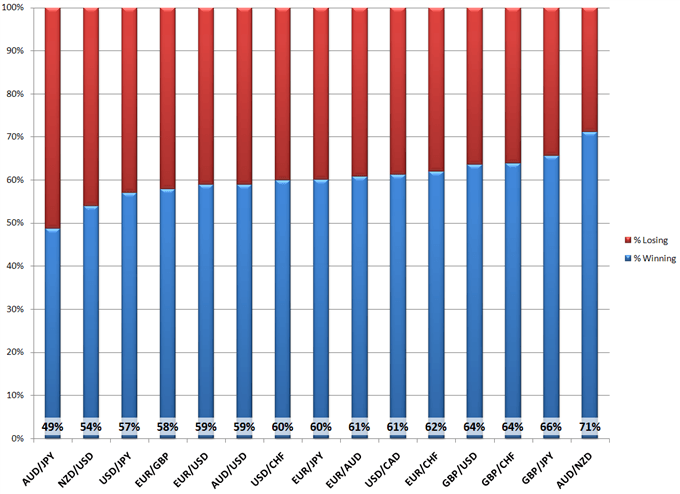
The above chart shows the results of a data set of over 12 million real trades conducted by clients from a major FX broker worldwide in 2009 and 2010. It shows the 15 most popular currency pairs that clients trade. The blue bar shows the percentage of trades that ended with a profit for the client. Red shows the percentage of trades that ended in loss. For example, in EUR/USD, the most popular currency pair, clients a major FX broker in the sample were profitable on 59% of their trades, and lost on 41% of their trades.
So if traders tend to be right more than half the time, what are they doing wrong?
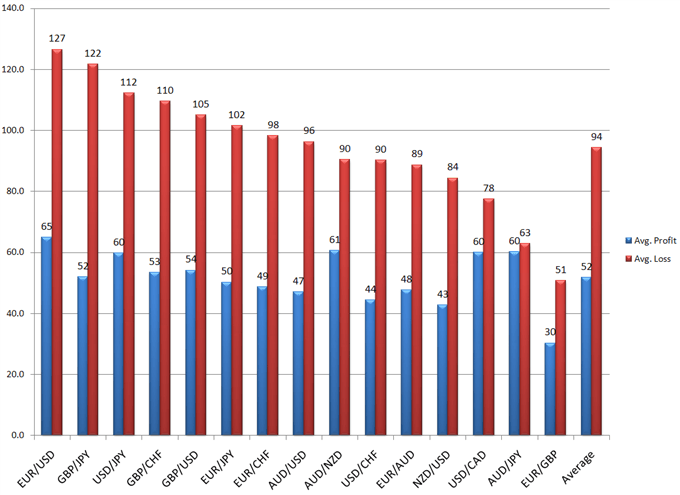
The above chart says it all. In blue, it shows the average number of pips traders earned on profitable trades. In red, it shows the average number of pips lost in losing trades. We can now clearly see why traders lose money despite bring right more than half the time. They lose more money on their losing trades than they make on their winning trades.
Let’s use EUR/USD as an example. We know that EUR/USD trades were profitable 59% of the time, but trader losses on EUR/USD were an average of 127 pips while profits were only an average of 65 pips. While traders were correct more than half the time, they lost nearly twice as much on their losing trades as they won on winning trades losing money overall.
The track record for the volatile GBP/JPY pair was even worse. Traders were right an impressive 66% of the time in GBP/JPY – that’s twice as many successful trades as unsuccessful ones. However, traders overall lost money in GBP/JPY because they made an average of only 52 pips on winning trades, while losing more than twice that – an average 122 pips – on losing trades.
Cut Your Losses Early, Let Your Profits Run
Countless trading books advise traders to do this. When your trade goes against you, close it out. Take the small loss and then try again later, if appropriate. It is better to take a small loss early than a big loss later. Conversely, when a trade is going well, do not be afraid to let it continue working. You may be able to gain more profits.
This may sound simple – “do more of what is working and less of what is not” – but it runs contrary to human nature. We want to be right. We naturally want to hold on to losses, hoping that “things will turn around” and that our trade “will be right”. Meanwhile, we want to take our profitable trades off the table early, because we become afraid of losing the profits that we’ve already made. This is how you lose money trading. When trading, it is more important to be profitable than to be right. So take your losses early, and let your profits run.
How to Do It: Follow One Simple Rule
Avoiding the loss-making problem described above is pretty simple. When trading, always follow one simple rule: always seek a bigger reward than the loss you are risking. This is a valuable piece of advice that can be found in almost every trading book. Typically, this is called a “risk/reward ratio”. If you risk losing the same number of pips as you hope to gain, then your risk/reward ratio is 1-to-1 (sometimes written 1:1). If you target a profit of 80 pips with a risk of 40 pips, then you have a 1:2 risk/reward ratio. If you follow this simple rule, you can be right on the direction of only half of your trades and still make money because you will earn more profits on your winning trades than losses on your losing trades.
What ratio should you use? It depends on the type of trade you are making. You should always use a minimum 1:1 ratio. That way, if you are right only half the time, you will at least break even. Generally, with high probability trading strategies, such as range trading strategies, you will want to use a lower ratio, perhaps between 1:1 and 1:2. For lower probability trades, such as trend trading strategies, a higher risk/reward ratio is recommended, such as 1:2, 1:3, or even 1:4. Remember, the higher the risk/reward ratio you choose, the less often you need to correctly predict market direction in order to make money trading.
Stick to Your Plan: Use Stops and Limits
Once you have a trading plan that uses a proper risk/reward ratio, the next challenge is to stick to the plan. Remember, it is natural for humans to want to hold on to losses and take profits early, but it makes for bad trading. We must overcome this natural tendency and remove our emotions from trading. The best way to do this is to set up your trade with Stop-Loss and Limit orders from the beginning. This will allow you to use the proper risk/reward ratio (1:1 or higher) from the outset, and to stick to it. Once you set them, don’t touch them (One exception: you can move your stop in your favor to lock in profits as the market moves in your favor).
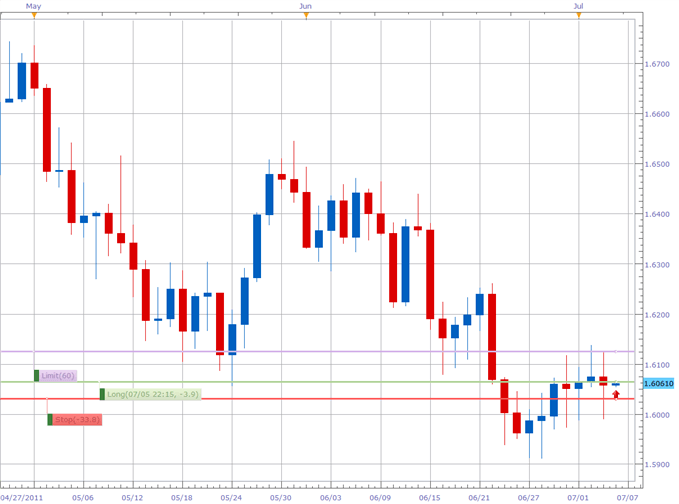
Managing your risk in this way is a part of what many traders call “money management”. Many of the most successful forex traders are right about the market’s direction less than half the time. Since they practice good money management, they cut their losses quickly and let their profits run, so they are still profitable in their overall trading.
Does This Rule Really Work?
Absolutely. There is a reason why so many traders advocate it. You can readily see the difference in the chart below.
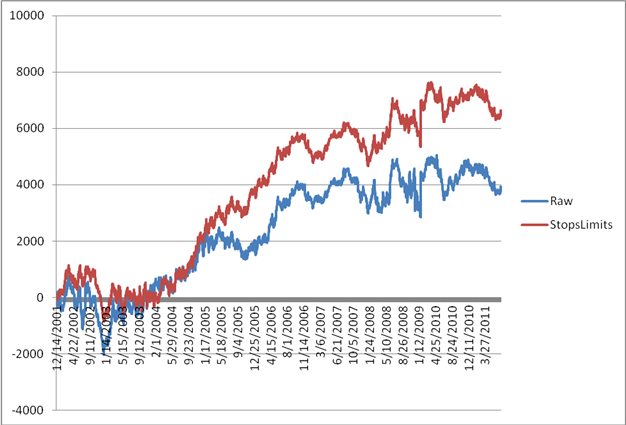
The 2 lines in the chart above show the hypothetical returns from a basic RSI trading strategy on USD/CHF using a 60 minute chart. This system was developed to mimic the strategy followed by a very large number of live clients, who tend to be range traders. The blue line shows the “raw” returns, if we run the system without any stops or limits. The red line shows the results if we use stops and limits. The improved results are plain to see.
Our “raw” system follows traders in another way – it has a high win percentage, but still loses more money on losing trades than it gains on winning ones. The “raw” system’s trades are profitable an impressive 65% of the time during the test period, but it lost an average $200 on losing trades, while only making an average $121 on winning trades.
For our Stop and Limit settings in this model, we set the stop to a constant 115 pips, and the limit to 120 pips, giving us a risk/reward ratio of slightly higher than 1:1. Since this is an RSI Range Trading Strategy, a lower risk/reward ratio gave us better results, because it is a high-probability strategy. 56% of trades in the system were profitable.
In comparing these two results, you can see that not only are the overall results better with the stops and limits, but positive results are more consistent. Drawdowns tend to be smaller, and the equity curve a bit smoother.
Also, in general, a risk/reward of 1-to-1 or higher was more profitable than one that was lower. The next chart shows a simulation for setting a stop to 110 pips on every trade. The system had the best overall profit at around the 1-to-1 and 1-to-1.5 risk/reward level. In the chart below, the left axis shows you the overall return generated over time by the system. The bottom axis shows the risk/reward ratios. You can see the steep rise right at the 1:1 level. At higher risk/rewards levels, the results are broadly similar to the 1:1 level.
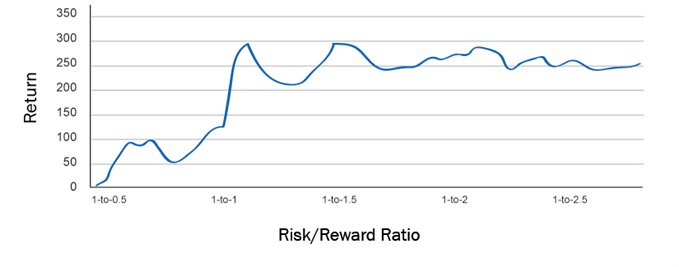
Again, we note that our model strategy in this case is a high probability range trading strategy, so a low risk/reward ratio is likely to work well. With a trending strategy, we would expect better results at a higher risk/reward, as trends can continue in your favor for far longer than a range-bound price move.
Game Plan: What Strategy Should I Use?
Trade forex with stops and limits set to a risk/reward ratio of 1:1 or higher
Whenever you place a trade, make sure that you use a stop-loss order. Always make sure that your profit target is at least as far away from your entry price as your stop-loss is. You can certainly set your price target higher, and probably should aim for 1:2 or more when trend trading. Then you can choose the market direction correctly only half the time and still make money in your account.
The actual distance you place your stops and limits will depend on the conditions in the market at the time, such as volatility, currency pair, and where you see support and resistance. You can apply the same risk/reward ratio to any trade. If you have a stop level 40 pips away from entry, you should have a profit target 40 pips or more away. If you have a stop level 500 pips away, your profit target should be at least 500 pips away.
Interested in developing your own strategy? On page 2 of our Building Confidence in Trading Guide, we help you identify your trading style and create your own trading plan.
Model Strategy:
For our models in this article, we simulated a “typical trader” using one of the most common and simple intraday range trading strategies there is, following RSI on a 15 minute chart.
Entry Rule: When the 14-period RSI crosses above 30, buy at market on the open of the next bar. When RSI crosses below 70, sell at market on the open of the next bar.
Exit Rule: Strategy will exit a trade and flip direction when the opposite signal is triggered.
When adding in the stops and limits, the strategy can close out a trade before a stop or limit is hit, if the RSI indicates that a position should be closed or flipped. When a Stop or Limit order is triggered, the position is closed and the system waits to open its next position according to the Entry Rule.
Next: Can You Use Fibonacci As A Leading Indicator? (25 of 50)
Previous: How to Trade with DMI
The Traits of Successful Traders
This article is Part 1 of our Traits of Successful Traders series.
Part 2: When is the Best Time of Day to Trade Forex?
Part 3: Here is How to Trade Forex Majors like the Euro During Active Hours




